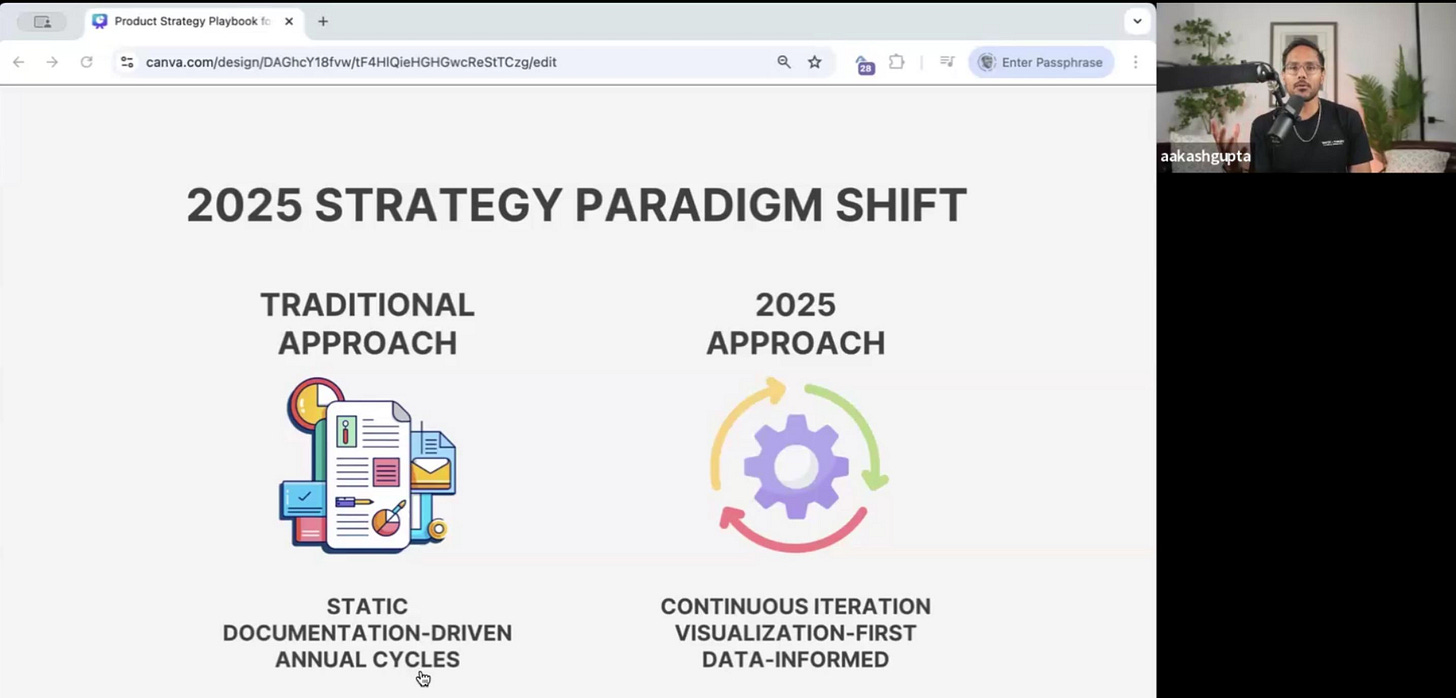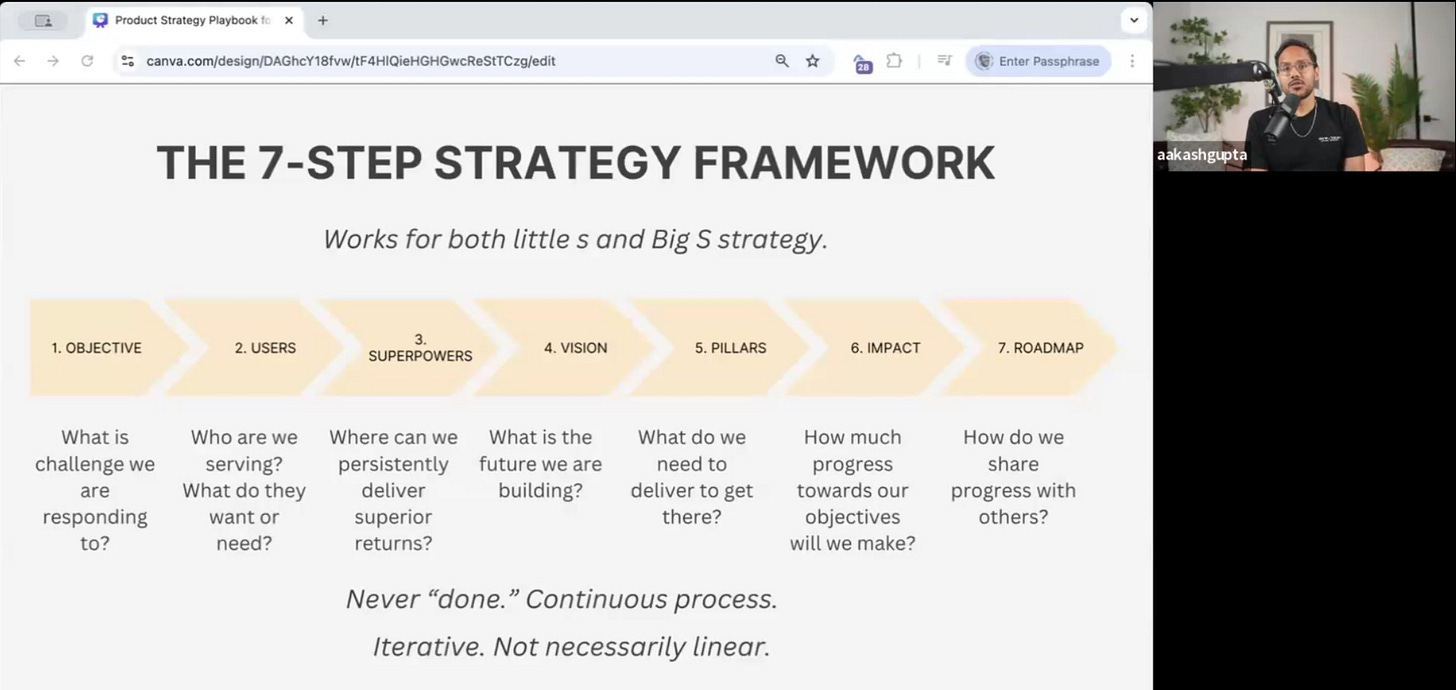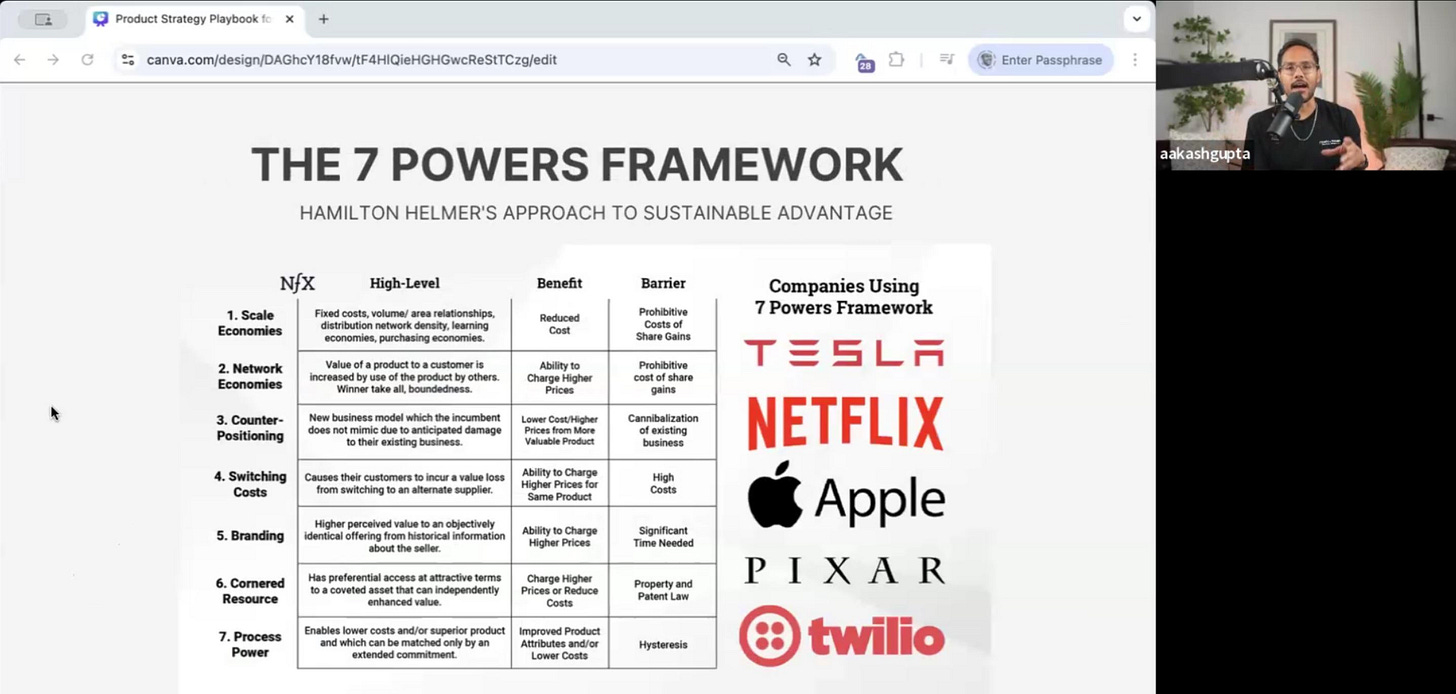💡Product Circle ⭕ Chat - Product Strategy with Aakash Gupta
At 💡 Product Circle ⭕ Chat 42 with Aakash Gupta we explored AI tools, real prototypes, and a 7-step process to make product strategy simple, fast, and repeatable.
💡Product Circle⭕ Chat runs every second week as a Zoom call that anyone can join to talk all things product, product management and problem solving. Creating value for customers and the business.
Best of all, when you attend live, you receive goodies like free courses and decks (like Janna Bastow provided), a free book (like Rich Mironov, Roman Pichler and others provided), access to their course for free (like John Cutler provided) and many more.
Don’t forget to follow the 💡Product Circle ⭕ Chat calendar on Luma and register for our next talk on 💡 Product Circle ⭕ Chat - Building Delightful Products with Nesrine Changuel on April 23
Become Irreplaceable in 2025
Before we get to Aakash’s talk (and recording) below, I’d like to share with you a few great courses I’m running. Both virtually and both based on my 20+ years in Product Management.
Product Growth Masterclass: Build a Growth Engine That Scales
🔥 Struggling to grow your product? Want to grow acquisition—without relying on expensive ads?
The secret? Growth is built into the product—not just marketing.
📅 Live, after work | 3 days | Starts end of April
In this Product Growth Masterclass, you'll discover how to:
Design a customer journey that drives engagement, retention, and referrals
Use behavioral psychology to create habit-forming product experiences
Implement growth loops that turn users into loyal advocates
Identify and remove friction from key moments in your user journey
Reduce churn and increase retention using proven frameworks
Track the right metrics at each stage of your product’s growth
Plus, you get the recordings, the slides and a certificate upon completion.
💡 Stop guessing. Start growing. Reserve your spot now!
Product Commercials Masterclass: Nail the Numbers. Influence with Confidence.
📊 Ever been asked, "What's the ROI?"
Struggled to explain P&L impact, breakeven, or why your product idea deserves investment?
That ends now.
📅 Live | 3 sessions after work | Starts May
🎓 Includes recordings, slides + certificate of completion
In the Product Commercials Masterclass, you’ll master the business side of product—without needing a finance degree. Learn how to:
✅ Decode the language of execs: P&L, ROI, breakeven, NPV and more
✅ Confidently build commercials to support your business case
✅ Model revenue, costs, and unit economics that make sense
✅ Forecast outcomes, stress-test assumptions, and spot risks early
✅ Build better buy-in with stakeholders using numbers they trust
✅ Influence investment decisions with clarity, not spreadsheets
Whether you're a PM pitching an idea, a Product Leader in boardrooms, or stepping into more commercial responsibility—this is your playbook.
💡 Great product ideas don’t just speak for themselves. You need the numbers to back them.
🎟 Reserve your spot and level up your commercial game.
Now let’s get back to Aakash’s talk on Building a Product Strategy in 2025
"Building is only half the battle. The other half? Getting people to care that you built it." - Aakash Gupta
This 💡Product Circle⭕ Chat was run on the 10 April 2025 at 9am (AEST) with Aakash Gupta
Recording below👇🏼
👷♂️ How to Build Product Strategy in 2025: A 7-Step Framework
If you’re in product, you’ve probably felt it: strategy documents that no one reads, plans that go stale in a quarter, and endless meetings where direction is more buzzword than beacon. In 2025, that doesn’t cut it anymore.
In the chat, we unpacked the 7-step strategy framework that product and growth expert Aakash Gupta shared during his 💡Product Circle⭕ Chat, based on Ed Biden's model. It’s fast, clear, and actually usable—designed for the realities of building and scaling products today.
Why Strategy Needs an Upgrade in 2025
Gone are the days when you could spend two months crafting a perfect product strategy deck. Today we’re facing a world where:
AI has accelerated prototyping, iteration, and execution.
Product teams are leaner and expected to do more with less.
Great strategies need to align cross-functional teams quickly and visually.
As Aakash put it: "We're drowning in documents but starving for direction."
What product teams need now is clarity, focus, and a repeatable way to build direction that scales. That’s where this 7-step process comes in.
🌟 The 7-Step Strategy Framework
1. Set Your Objective
Define a mission with a measurable goal. Think: “Increase 30-day retention from 18% to 22% by end of Q3.”
This sets the focus. Without it, you’re optimising in all directions and gaining traction in none.
2. Understand Your Users
Use journey mapping, interviews, and the Jobs to Be Done framework to deeply understand what your users are trying to accomplish—not just what features they want.
As Aakash said: "Slack didn’t build better email. They understood the real job was team communication."
3. Identify Your Superpowers
What is your product’s unfair advantage? Use the 7 Powers framework (by Hamilton Helmer) to evaluate your defensibility: Network Effects, Scale Economies, Brand, Counter-Positioning, etc.
4. Show the Future
Replace walls of text with prototypes, mockups, or short videos. Use tools like Bolt, Cursor, Lovable, or Replit to rapidly build clickable prototypes without waiting on design bandwidth.
📹 Aakash’s tip: "A prototype is worth 10,000 words."
5. Choose Your Pillars
These are your 2–4 big bets—the themes that will deliver on your objective. Avoid the trap of 10+ priorities. Great strategy is about what you don’t do.
Netflix in 2009:
Transition from DVD to streaming
Expand device support
Improve content licensing
That’s it.
6. Quantify Your Impact
Every pillar should have a metric. What will it move? By how much? Tie these to revenue, cost savings, or user impact. Aakash gave both revenue-side (ARR, EBITDA) and cost-side (efficiency, productivity) examples.
Show your work. Strategy isn’t vision without numbers.
7. Plan Your Path
Now, translate the strategy into a flexible roadmap: problems to solve, outcomes to drive, experiments to run. Show strong commitment to objectives, medium to problems, and low to specific solutions. This keeps you agile and open to learning.
🏋️ From Strategy Document to Strategy Culture
What sets this framework apart is how actionable it is. You don’t need months. You don’t need 40 slides. You need:
2 hours to sketch a Day One Strategy
1 week to test, prototype, and validate
1 month to socialise and refine
Most importantly, it moves you from strategy as a document to strategy as a practice.
"If your team can't explain the strategy in 30 seconds, it's not a strategy. It's a document."
Building a Strategy in 2 Hours
What if your product strategy didn’t need to take weeks of planning, countless workshops, and a 40-slide deck to get buy-in?
Aakash took us through a focused Day One strategy that could be drafted in just two hours. Yes, really.
Built on clarity, speed, and iteration, this method moves beyond static docs to a practice you can actually build momentum with.
🔥 Why Day One Matters
Most product managers overthink strategy. We assume it has to be polished, perfect, and packed with consensus before we can begin. The Day One Strategy flips that.
“It’s like writing: get something down fast so you have something to react to.” — Aakash Gupta
Instead of waiting for the perfect plan, start with what you know now—and refine as you go.
🔢 The Day One → Week One → One Month Strategy Path
✅ Day One Strategy (2 hours)
Use this to clarify your thinking and kickstart direction fast:
Draft your objective
Mission + Metric (e.g. "Increase 30-day retention from 18% to 22% by Q3")
List key user needs
Based on recent interviews or JTBD mapping
Identify 1–2 superpowers
What makes your product defensible?
Sketch vision elements
Use a prototype tool or storyboard your idea
Name 2–3 strategic pillars
These are your big bets to deliver on your objective
Outcome: A simple, clear, 5–6 page doc that aligns your thinking and seeds the conversation.
📊 Week One Strategy (5 days)
Validate and pressure test your draft:
Test your objective with leadership and cross-functional leads
Conduct 5–8 user interviews to validate needs
Assess competitor responses and edge
Refine your vision prototype with user feedback
Estimate impact of your strategic pillars
Use tools like Bolt, Cursor or Replit to create rapid prototypes and show direction visually.
📆 One Month Strategy (30 days)
Now it gets real. Expand your draft into a shared vision with broad alignment:
Layer in design sprints: Map challenges, sketch, prototype, test
Validate hypotheses with data and user testing
Socialise across functions: product, engineering, design, marketing
Prioritise initiatives and build roadmap
Deliverables:
1-pager for execs (business value)
Visual roadmap for teams (problems, outcomes)
Customer preview (benefits, outcomes coming soon)
🏋️ Strategy Is a Practice, Not a Deck
The Day One approach isn’t about being sloppy—it’s about starting. You’re giving yourself and your team a stake in the ground to align around.
When you move quickly, test early, and bring others into the process, strategy becomes something you do rather than something you present.
Want to try it? Block 2 hours on your calendar. Pull out a doc. Start building.
Product Circle Chat 42 - Topic
Topic: The 2025 Product Strategy Playbook.
Product Strategy. How to develop it and why yours probably sucks.
Product Circle Chat 42 - Video
Product Circle Chat 42 - Speaker
Aakash Gupta is a product and growth mastermind who’s spent over 15 years figuring out what makes products (and careers) skyrocket. He’s led product teams at Google, thredUP, and Apollo.io—where he helped the company hit over $1 billion valuation—and now runs his own media company, dedicated to helping product managers and founders win big.
If you're into product, growth, and career success, you’ve probably come across his Product Growth newsletter, his Product Growth Podcast, or his hot takes on LinkedIn and X (formerly Twitter). He’s also the author of The Ultimate Guide to Getting a PM Job, which has helped thousands of PMs land their dream roles.
Aakash is the guy who tells it like it is—whether he's breaking down growth strategies, teaching you how to nail your next PM job, or revealing the no-BS truths about the industry. He’s spoken at PM conferences worldwide, coached product managers, and built a loyal audience of PMs who want to level up and get ahead.
Links:
Product Circle Chat - Q&A
❓ How do I get involved?
1. Subscribe to the Product Circle Chat Calendar on Lu.ma and get notified of every 💡 Product Circle ⭕ Chat event
2.Register & Show up - Register to the Product Circle Chat event, block your calendar out and come to the next Chat 📅
3. Share - bring a friend or two who wants to talk all things Product 👯♂️👯♀️
4. Volunteer - volunteer to host or present at one of the future Product Circle Chats 🙋♀️. Drop me an email at irene@phronesisadvisory.com
❓ Will there be more sessions?
Yes. Fortnightly. Every second week.
❓ What if I can’t make the next session or don’t want to miss the next Product Circle chat invite?
Really want to come to the session but 😭 can't make this specific 💡 Product Circle ⭕ Chat?
📆 Get an invite directly into your inbox
👉 Subscribe to the Product Circle Chat Calendar on Lu.ma and get notified of every 💡 Product Circle ⭕ Chat event
💪 We've got you!
❓ Still have Questions?
Talk to me. Send me an email at irene@phronesisadvisory.com
Are you new to Product Management and want to learn from me?
I created a Course. For people new to Product Management.
Aligned it with the Learning Outcomes created by Product greats like Jeff Patton and others. Had it certified by the globally recognised ICAgile.
Choose to spend 2 days learning from me - either face to face or via Zoom - with ICAgile Certified Professional in Product Management (ICP-PDM).
And if you’re looking for a sneaky discount, send me an email at irene@phronesisadvisory.com






